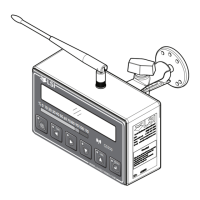40 The GS550 System
Radius
Radius Verification and Adjustment
1. Verify the boom and luffing jib
*
angles, and the boom length
†
, are indicated correctly.
2. Verify the correct rated capacity chart is selected
‡
.
3. Test № 1: measure the actual radius and compare to the radius indicated. Repeat with the
boom at minimum angle, at 45 degrees, and at maximum angle; repeat at minimum and maxi-
mum boom length
†
. If radius indication is not accurate then go to step 4.
4. Measure the basic radius parameters on the crane (see pages 42 and 43).
5. Program the basic radius parameters in the radius settings menu (see page 41).
6. Test № 2: measure the actual radius and compare to the radius indicated. Repeat with the
boom at minimum angle, at 45 degrees, and at maximum boom angle; repeat at minimum and
maximum boom length
†
. If radius indication is not accurate then go to the next step.
Tip: If the difference between the displayed radius and actual radius remains constant at all boom
lengths and angles, then correct by adjusting the slew offset. For example: if the radius displayed
is always 2.3 feet longer than the actual radius, then subtract 2.3 from the slew offset.
7. If the crane is rigged with the main boom only, then go directly to step 11.
8. If the crane is rigged with a rooster, jib, or other extension then the advanced radius parame-
ters must be measured on the crane (see page 44) and then programmed in the radius settings
menu of the display (see page 41).
9. Test № 3: measure the actual radius and compare to the radius indicated. Repeat with the
boom at minimum angle, at 45 degrees, and at maximum boom angle; repeat at minimum and
maximum boom length
†
. If radius indication is not accurate then go to the next step.
10. Test for boom deflection: is the radius indicated equal to the actual radius with the boom at 0
degrees and at 90 degrees but greater than the actual radius with the boom at 45 degrees? If
yes then adjust the boom deflection value to compensate:
a. Raise the boom to 45 degrees with a known load.
b. Compare the indicated radius with the actual radius. Change the boom deflection value
and again compare the radius displayed with the actual radius. Repeat until the radius
displayed equals the actual radius.
Tip: with the boom at 45° and the maximum load on the hoist, the boom deflection value should
equal the difference between the actual and the displayed radius. With the boom at 45° and half
the maximum load on the hoist, the boom deflection value should equal twice the difference
between the actual and the displayed radius.
11. Test № 4: measure the actual radius and compare to the radius indicated. Repeat with the
boom at minimum angle, at 45 degrees, and at maximum boom angle; repeat at minimum and
maximum boom length
†
. If radius indication is not accurate then go to the next step.
*
When the hoist is rigged off a luffing jib only
†
Telescopic boom cranes only
‡
Systems with rated capacity charts programmed in the GS550 only
SkyAzúl, Equipment Solutions

